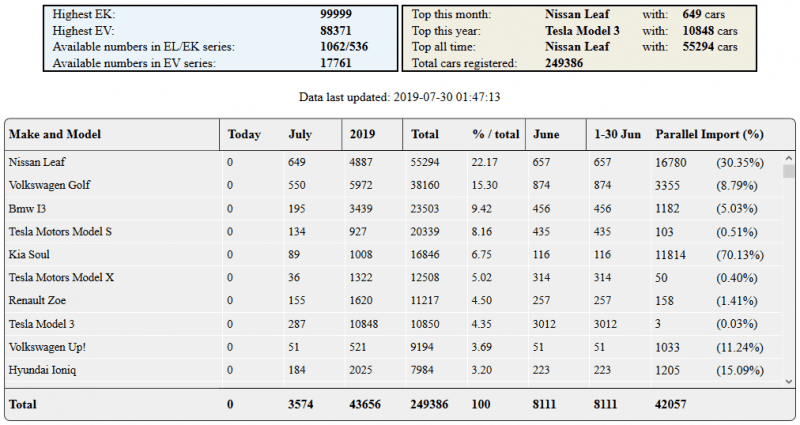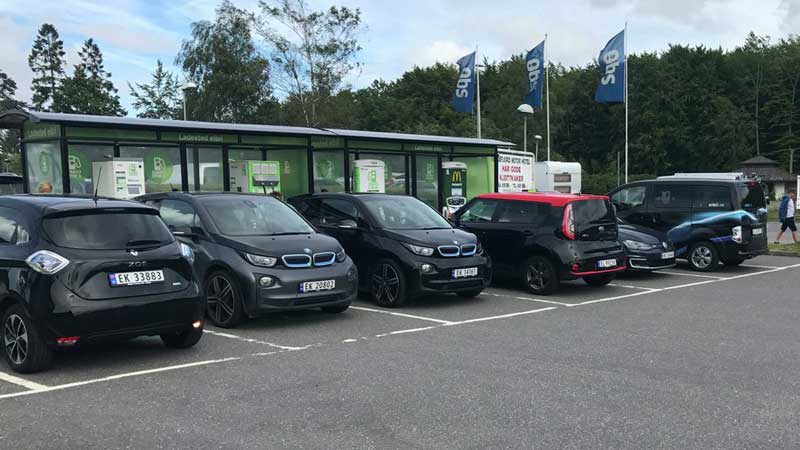Electric car drivers in Norway are encountering what is an increasing phenomenon in the transition to EVs, with almost two-thirds reporting they are now waiting in queues to use DC fast chargers.
As electric vehicle registrations in the Scandinavian country approach a record 250,000, drivers are increasingly facing a wait to recharge their vehicles using the DC units, which can add significant range to EVs in minutes, instead of hours.
In a study released overnight (Australian time) by the Norwegian Electric Vehicle Association, 85 per cent of electric car drivers in Norway (which has the world’s largest EV market by share and around 60 per cent of car sales each month are electric) use fast chargers on a regular basis.
Of those, 64 per cent say they are waiting in queues to use DC fast chargers, a major increase of 10 per cent from last year, and 25 per cent in 2017.
The demand for fast chargers is highest in the Norwegian capital of Oslo, where 75 per cent of drivers reported queueing, according to the study which aggregated responses from over 16,000 EV drivers across the country. Other counties, including Oppland, Vestfold and Buskerud, reported 70 per cent of drivers experienced queueing.
The rapid uptake of EVs in Norway, which has been accelerated by an ambitious target of 100 per cent electric car sales by 2025, is the core reason for the problem – although it’s perhaps not the worst problem to have!
There are almost 2,000 fast chargers in Norway to service the quarter of a million EVs on the road, and while EV drivers commonly recharge their vehicles overnight at home, secretary general of the Norwegian Electric Car Association Christina Bu says that approximately 1,200 new chargers a year need to be installed to keep pace.
While private market providers of EV fast chargers are more than able to keep up with demand, Bu says that the Norwegian government should offer startup assistance and appropriate framework to ensure market can continue to meet demand.
Interestingly, the study also shows that it is owners of EVs with longer range use fast chargers more often than those with shorter range, indicating that as vehicle range increases, Norwegians are increasingly choosing to use electric vehicles for long distance trips instead of petrol or diesel vehicles.
That revelation may be a good indicator for the EV market and infrastructure needs in Australia.
This would by and large be due to Tesla, whose cars accounts for about 17.5 per cent of the total EV market in Norway according to Elbil Statistikk.
With ranges that exceed most other vehicles (the Kona Electric is the other notable long range vehicle on the Norwegian market, but that accounts for just 1.24 per cent of the EV market share), the Model S, X and 3 combined have the third largest share in the market.

The most popular single model is the Nissan Leaf, which is the most popular EV in Norway at 22 per cent market share. This has a driving range of just 270km according to the WLTP standard, while other popular models include the VW e-Golf (15.3% market share) with a driving range of 230km (WLTP) and the BMW i3 (9.42% market share) with a range of 310km (WLTP).
For more EV driving range info check out this handy graph also produced by the Norwegian Electric Vehicle Association:

Bridie Schmidt is associate editor for The Driven, sister site of Renew Economy. She has been writing about electric vehicles since 2018, and has a keen interest in the role that zero-emissions transport has to play in sustainability. She has participated in podcasts such as Download This Show with Marc Fennell and Shirtloads of Science with Karl Kruszelnicki and is co-organiser of the Northern Rivers Electric Vehicle Forum. Bridie also owns a Tesla Model Y and has it available for hire on evee.com.au.

